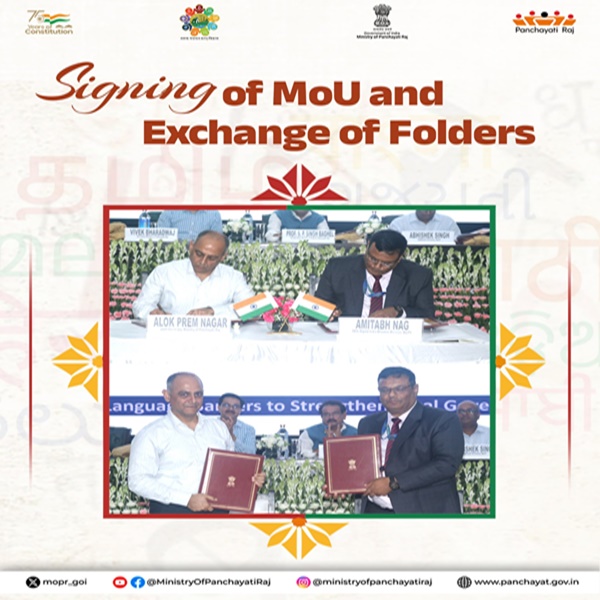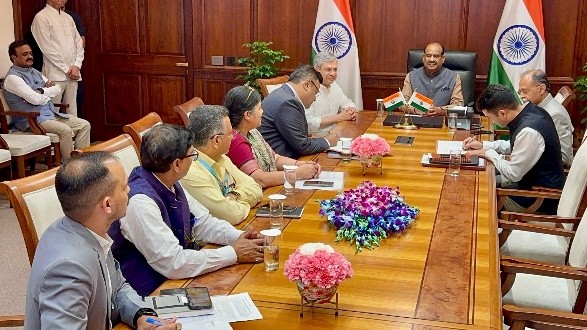Bhashini

- 22 Jun 2025
In News:
The Ministry of Panchayati Raj (MoPR) has signed a Memorandum of Understanding (MoU) with Bhashini, the National Language Translation Mission (NLTM), to integrate AI-enabled multilingual tools into rural e-governance platforms.
About Bhashini
- Developed by: Ministry of Electronics and Information Technology (MeitY)
- Purpose: Acts as a digital public infrastructure for real-time, AI-powered translation across Indian languages.
Objective of the MoU
- To build an inclusive, multilingual e-governance ecosystem for Panchayati Raj Institutions (PRIs).
- To bridge language barriers in rural governance and foster participatory democracy.
Key Features of the Initiative
- AI-Driven Language Translation: Offers real-time speech-to-text and text-to-text translation in major Indian languages.
- Platform Integration: Bhashini tools to be integrated with MoPR’s digital platforms like eGramSwaraj, ensuring multilingual access to rural governance services.
- Citizen-Centric Approach: Enables rural citizens to interact with digital governance platforms in their native language, enhancing accessibility and inclusion.
- Promotes Digital Inclusion: Supports rural digital literacy by making digital interfaces linguistically accessible.
- Enhances Transparency and Trust: Facilitates better information dissemination, increasing trust and engagement in local self-governance.
Significance
- Aligns with Digital India goals.
- Empowers Gram Panchayats by ensuring language is not a barrier to governance.
- Sets a precedent for AI-driven, citizen-centric governance reforms.
SansadBhashini Initiative

- 21 Mar 2025
In News:
The SansadBhashini Initiative is a collaborative project between the Lok Sabha Secretariat and the Ministry of Electronics and Information Technology (MeitY), launched to enhance digital and linguistic accessibility in India's parliamentary functioning.
About SansadBhashini
- Objective:To provide real-time AI-powered translation and transcription of parliamentary proceedings and documents across multiple Indian languages, ensuring greater transparency, inclusivity, and accessibility.
- Associated Platform:It is built on MeitY’sBhashini platform, a part of the National Language Translation Mission (NLTM), focused on democratizing access to digital content in Indian languages.
Key Features and Technologies Used
- AI-Powered Real-Time Translation: Enables instantaneous multilingual translation of legacy debates, legislative documents, and committee reports.
- Speech-to-Text Transcription System
- Converts spoken parliamentary debates into text with features such as:
- Background noise reduction
- Customizable vocabulary suited for legislative discourse
- High transcription accuracy
- Converts spoken parliamentary debates into text with features such as:
- Automatic Summarization: Generates concise and coherent summaries of long parliamentary discussions, aiding in faster decision-making and better public understanding.
- AI-Driven Chatbot Support
- Assists MPs, researchers, and officials with quick access to:
- Procedural rules
- Parliamentary archives
- Legislative documents
- Assists MPs, researchers, and officials with quick access to:
- Multilingual Accessibility and Inclusivity: Enhances linguistic diversity in governance by making proceedings available in multiple regional languages, thereby fostering greater public engagement.
Significance
- Strengthens e-Governance and digital democracy by making Parliament more accessible to citizens, especially non-Hindi/English speakers.
- Enhances documentation, transparency, and archiving through digitization and AI tools.
- Empowers MPs and legislative staff with real-time information and language tools, improving efficiency.
- Supports India’s Digital India mission and promotes linguistic equity in democratic institutions.
Bhashini Initiative
- 09 Jan 2025
In News:
e-Shram Portal, which aims to provide social security benefits to unorganised workers, has been upgraded with multilingual functionality for all 22 scheduled languages of India. This development, supported by the Bhashini Initiative, ensures that unorganised workers from diverse linguistic backgrounds can access the portal more easily and benefit from government welfare schemes.
About Bhashini Initiative:
- Launched in: July 2022
- Developed by: Ministry of Electronics and Information Technology (MeitY)
- Aim: To eliminate language barriers in accessing digital services by making AI and Natural Language Processing (NLP) tools publicly available.
Key Features:
- Local Language Translation: Bhashini offers AI-powered translation services in 22 scheduled Indian languages to ensure that digital platforms like e-Shram are accessible to everyone in their native languages.
- Open AI and NLP Resources: These tools are made available to Indian MSMEs, startups, and innovators to create a more inclusive digital ecosystem.
- Crowdsourcing Platform (Bhashadaan): A platform for people to contribute to building linguistic datasets through initiatives like Suno India, Likho India, Bolo India, and Dekho India, furthering language diversity in digital services.
- National Digital Public Platform: Aimed at providing universal access to digital content in all Indian languages, facilitating smoother communication across regions.
e-Shram Portal: A One-Stop Solution for Unorganised Workers
- Purpose: The e-Shram portal was created to provide unorganised workers with access to social security benefits and welfare schemes.
Recent Upgrade:
- Multilingual Functionality: The portal has now been upgraded to support 22 scheduled languages, making it more inclusive and user-friendly for workers who speak various regional languages.
- Previous Version: Previously, the portal was only available in English, Hindi, Kannada, and Marathi. The integration of 22 languages is a significant improvement, enabling broader participation.
Importance of the e-Shram Portal for Unorganised Workers:
- Welfare Access: The portal provides access to government schemes designed for the welfare, livelihood, and well-being of unorganised workers, including gig and platform workers and building and construction workers.
- Integration of Social Security Schemes:
- As of now, the portal facilitates access to 12 government schemes, with plans to integrate even more, including state-level programs.
- Future plans include launching a mobile app, a single application form, and the integration of payment gateways for faster disbursement of benefits.
